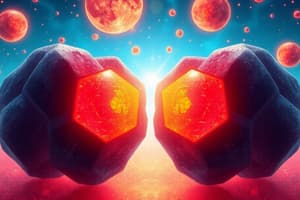Podcast
Questions and Answers
Which type of bonding is responsible for holding ionic compounds together?
Which type of bonding is responsible for holding ionic compounds together?
- Hydrogen bonding
- Covalent bonding
- Metallic bonding
- Ionic bonding (correct)
Why do ionic compounds have high melting and boiling points?
Why do ionic compounds have high melting and boiling points?
- They have a large number of ions (correct)
- They have covalent bonds
- They have metallic bonds
- They have weak forces of attraction
Which term describes the regular structures of ionic compounds?
Which term describes the regular structures of ionic compounds?
- Metallic crystals
- Giant ionic lattices (correct)
- Covalent networks
- Giant molecular lattices
What type of forces of attraction act between the oppositely charged ions in a giant ionic lattice?
What type of forces of attraction act between the oppositely charged ions in a giant ionic lattice?
What property of ionic compounds is explained by their structure and bonding?
What property of ionic compounds is explained by their structure and bonding?
What happens to the melting and boiling points of ionic compounds as the energy needed to overcome the electrostatic forces of attraction increases?
What happens to the melting and boiling points of ionic compounds as the energy needed to overcome the electrostatic forces of attraction increases?
Which compound is commonly found in sand?
Which compound is commonly found in sand?
What type of structure does silicon dioxide have?
What type of structure does silicon dioxide have?
What type of bonds link the atoms in silicon dioxide?
What type of bonds link the atoms in silicon dioxide?
What are the melting and boiling points of substances with giant covalent structures?
What are the melting and boiling points of substances with giant covalent structures?
Which substance is an exception and can conduct electricity among substances with giant covalent structures?
Which substance is an exception and can conduct electricity among substances with giant covalent structures?
Flashcards are hidden until you start studying




